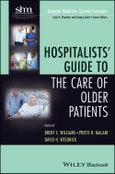The first book designed specifically for hospitalists and other hospital-based staff who need concise, evidence-based guidance on the vital topic of caring for older hospitalized patients
Hospitalists' Guide to the Care of Older Patients is an up-to-date, practical reference in geriatric medicine for hospitalists, as well as other physicians and nurses working in the hospital setting. The book uses numerous tables, figures, and images to highlight the areas of geriatric medicine that are most relevant to hospitalists.
Written by nationally recognized experts, chapters broadly follow the course of hospitalization, from admission through daily care and active management of the transition to post-hospital settings, providing practical, evidence-based guidance at each point. Contents include:
- A systematic approach to the care of older patients, emphasizing clinical skills and daily activities that can be implemented in today's hospital environment
- Techniques for effective communication with patients and their caregivers
- Tools and "pearls" for quickly and accurately assessing the whole patient, including risk for in-hospital complications, function, decision-making capacity, and home support
- Best practices for prevention and management of the complications of hospitalization, including delirium, falls, pressure ulcers, and hip fractures
- Specific recommendations in areas with wide practice variation, such as psychopharmacology and nutrition in older hospitalized patients
- Practical guidance on complex issues, such as establishing goals of care, managing patients who lack decision-making capacity, and managing the discharge transition
- Methods to improve the daily work and communication of the whole hospital team, including physicians, nurses, and other healthcare providers
As the population ages, hospitalists are caring for an increasing number of older patients. This book helps hospitalists expand their knowledge, incorporate key clinical skills into daily practice, build more efficient patient care teams, and teach more effectively in today's fast-paced, complex hospital environment.
Table of Contents
CONTRIBUTORS vii
CHAPTER 1 INTRODUCTION AND OVERVIEW 1
Brent C. Williams, Preeti N. Malani, and David H. Wesorick
CHAPTER 2 THE HOSPITALIZED OLDER ADULT: COMMUNICATION AND PHYSICAL EXAMINATION 5
Mark E. Williams
CHAPTER 3 GERIATRIC ASSESSMENT FOR THE HOSPITALIST 17
Brent C. Williams
CHAPTER 4 INFORMED DECISION-MAKING AND THE EVALUATION OF DECISION-MAKING CAPACITY 31
Lisa S. Seyfried, Esther O. Akinyemi, and Scott Y.H. Kim
CHAPTER 5 CARING FOR PATIENTS WITH LIMITED PROGNOSIS: NEGOTIATING GOALS OF CARE AND PLANNING FOR THE END-OF-LIFE 47
Adam D. Marks and Caroline A. Vitale
CHAPTER 6 GERIATRIC PHARMACOTHERAPY 65
Gabe Solomon, Macgregor A. Montaño, and Paul C. Walker
CHAPTER 7 MANAGING BEHAVIORAL DISTURBANCES WITH PSYCHOACTIVE MEDICATIONS: DOS, DON’TS, AND MAYBES 93
David C. Belmonte, Jolene Bostwick, and Amy B. Rosinski
CHAPTER 8 ISSUES AND CONTROVERSIES SURROUNDING NUTRITION IN HOSPITALIZED OLDER ADULTS 115
Lauren W. Mazzurco, Joseph Murray, and Caroline A. Vitale
CHAPTER 9 HIP FRACTURE: MANAGING THE MEDICALLY COMPLEX, OLDER SURGICAL PATIENT 141
Paul J. Grant
CHAPTER 10 FALLS AND MOBILITY DURING HOSPITALIZATION 165
Cynthia J. Brown and Donna M. Bearden
CHAPTER 11 PRESSURE ULCERS: A PRIMER FOR THE HOSPITALIST 181
Aimée D. Garcia
CHAPTER 12 DELIRIUM 203
Tia R.M. Kostas and James L. Rudolph
CHAPTER 13 TRANSITIONAL CARE PLANNING: ASSURING A SAFE DISCHARGE 225
Satyen Nichani, Darius Joshi, and Christopher S. Kim
INDEX 247








